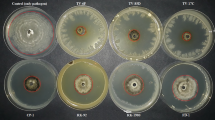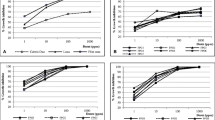Abstract
The effect of a number of fungicides on mycelial growth ofDidymella bryoniae on agar was tested and compared with the effect on inoculated plants and in commercial crops. Activities in vitro and vivo are not always correlated. Spraying of inoculated young plants is a reliable and quick method for testing fungicides againstD. bryoniae.
In commercial crops the treatments in decreasing order of effectiveness were weekly sprays of benomyl 0.025–0.05% active ingredient (a.i.), chlorothalonil 0.15% and triforine 0.02% a.i. These chemicals should be sprayed alternately to prevent the development of strains tolerant to benzimidazole derivates.
Samenvatting
Een aantal chemische middelen zijn in vitro en op verschillende manieren in vivo getoetst op hun werking tegenDidymella bryoniae. De resultaten in vitro zijn niet altijd positief gecorreleerd met die in vivo (Tabel 1 en 2). De resultaten na inoculatie van jonge plantjes komen wel overeen met die onder praktijkomstandigheden (Tabel 3, 4 en 5). Op jonge plantjes kunnen dus middelen op een snelle wijze en in een beperkte ruimte betrouwbaar worden getoetst.
Onder praktijkomstandigheden werd het beste resultaat verkregen met benomyl 0,025–0,05% actieve stof, zowel wat betreft de gewas- als de vruchtaantasting. Hierop volgde chloorthalonil 0,15% a.s. en triforine 0,02% a.s. (Tabel 4 en 5). IndienD. bryoniae met chemische middelen moet worden bestreden, is het noodzakelijk dat er bijna elke week wordt gespoten (Tabel 5). Teneinde het ontstaan van resistentie van schimmels tegen benomyl en andere MBC-producerende fungiciden te voorkomen, wordt aanbevolen om benomyl, chloorthalonil en triforine afwisselend toe te passen. Met dit schema worden vele andere schimmelziekten in komkommer eveneens bestreden.
Similar content being viewed by others
References
Anonymus, 1975. Gids voor ziekten- en onkruidbestrijding in land- en tuinbouw, 5th ed. Consulentschappen voor Planteziektenbestrijding, Wageningen. 375 pp. (cf. pp. 194–196).
Boerema, G. H. & Van Kesteren, H. A., 1972. Enkele bijzondere schimmelaantastingen IV (Mycologische Waarnemingen no. 16). Gewasbescherming 3: 65–69.
Chupp, Ch. & Sherf, A. F., 1960. Vegetable diseases and their control, The Ronald Press Company, New York, 693 pp. (cf. pp. 314–317).
Davidse, L. C., 1973. Antimitotic activity of methyl benzimidazol-2-yl carbamate inAspergillus nidulans. Pestic. Biochem. Physiol. 3: 317–325.
Fletcher, J. T. & Preece, T. F., 1966.Mycosphaerella stem rot of cucumbers in the Lea Valley. Ann. appl. Biol. 58: 423–430.
Grouet, D., 1974. Problème posé actuellement par la lutte chimique contre l'Ascochyta chrysanthemi (Didymella ligulicola). Phytiat. Phytopharm. 23: 175–182.
Sherald, J. L. & Sisler, H. D., 1975. Antifungal mode of action of triforine. Pestic. Biochem. Physiol. 5: 477–488.
Steekelenburg, N. A. M. Van, 1973.Ascochyta bij chrysant resistent geworden tegen benomyl (Benlate). Vakbl. Bloemisterij 28 (41): 13.
Steekelenburg, N. A. M. Van, 1976.Didymella chrysanthemi (Ascochyta-ziekte) bij chrysant. Jversl. Inst. plziektenk. Onderz. 1975: 32–33.
Veenman, A. F., 1972.Mycosphaerella in komkommers. Tuinderij 12 (10): 24–27.
Vincent, Ph. G. & Sisler, H. D. 1968. Mechanism of antifungal action of 2, 4, 5, 6-tetrachloroisophtalonitrile. Physiol. Pl. 21: 1249–1261.
Author information
Authors and Affiliations
Rights and permissions
About this article
Cite this article
Van Steekelenburg, N.A.M. Chemical control of Didymella bryoniae in cucumbers. Netherlands Journal of Plant Pathology 84, 27–34 (1978). https://doi.org/10.1007/BF01978100
Accepted:
Issue Date:
DOI: https://doi.org/10.1007/BF01978100




